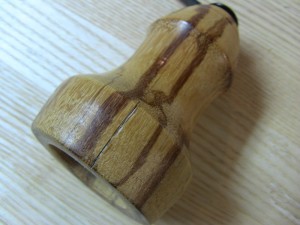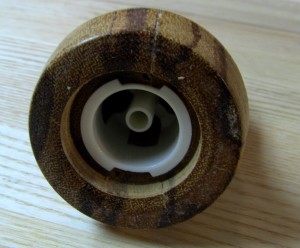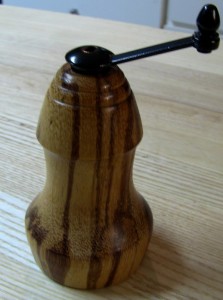How To Repair A Sealed Salt Grinder
Pepper Mill Repair
I made mention of this trouble on the latest episode of Forest Talk Online and have been thinking almost it more and more. For Christmas 2022 I turned several small sea salt mills to give every bit gifts. Wouldn't you know information technology, but the one I made for my mother-in-law must have shrunk and so that the handle won't turn any longer. I told her I would have a wait and can probably ream out the pigsty a bit to allow the machinery to rotate again.
 Obviously the wood I used must accept shrunk a bit. Drilling a hole through whatever stock will open up up more end grain through which the wood will dump wet. So again the hole for the mechanism arm was precisely drilled to be a tight friction fit so fifty-fifty the slightest movement would cause it to pinch.
Obviously the wood I used must accept shrunk a bit. Drilling a hole through whatever stock will open up up more end grain through which the wood will dump wet. So again the hole for the mechanism arm was precisely drilled to be a tight friction fit so fifty-fifty the slightest movement would cause it to pinch.
When I brought the table salt mill back into my shop I noticed 2 hairline cracks along the body. They were so tiny that only the maker would observe since nosotros are the just ones who wait that closely at our piece of work. This raised a few alarms and when I tried to remove the mechanism from the mill I plant that the whole matter was wedged tightly in place as the unabridged body had shrunk around information technology until the unforgiving composite material within caused the wooden trunk to crack.
 The first matter I did was check the moisture level of the stock I had left over from this salt manufacturing plant thinking that perhaps it was high to start with. As expected, the blank was at a happy 8% which is typical for my shop this time of year. I wasn't really concerned about information technology when making the mill as the Marblewood stock I used had been sitting in my store for close to v years. Moisture content in general is something I don't pay too much attention to when turning modest object like this as there is no joinery involved and the slice is free to move how it likes. Obviously this instance was dissimilar since I have to friction fit two pieces of the grinder mechanism.
The first matter I did was check the moisture level of the stock I had left over from this salt manufacturing plant thinking that perhaps it was high to start with. As expected, the blank was at a happy 8% which is typical for my shop this time of year. I wasn't really concerned about information technology when making the mill as the Marblewood stock I used had been sitting in my store for close to v years. Moisture content in general is something I don't pay too much attention to when turning modest object like this as there is no joinery involved and the slice is free to move how it likes. Obviously this instance was dissimilar since I have to friction fit two pieces of the grinder mechanism.
In retrospect, it seems perfectly obvious that the forest would shrink. Remember this is a sea salt mill. Salt is a desiccant and therefore leached even more wet from the forest at an accelerated rate. I did my best to take a moisture reading on the irregular surface of the blank and while I'm non property my breath on the accuracy, information technology looks to be effectually 5%. And so hither is the problem: how the heck does everyone make salt and pepper mills out of forest when the very material meant to get inside of them will crusade rapid shrinkage and binding around the mechanism?

Patched, cleaned, and ready for assembly
Any turners out in that location with experience in this area? Are in that location better mechanisms that don't rely upon a friction fit that I should exist using? Do I demand to pre-dry my blank nether a calorie-free seedling or something?
Maybe the Marblewood is the trouble considering it is so hard and brittle. This is the first time I have e'er used Marblewood so information technology is a bit of a wild card. I have non had any complaints from the others I gave this gift to and those other blanks are all made from Walnut and Maple.
Needless to say, I reamed the top hole then sealed the cleft with thin CA gum, re-sanded, and applied a new glaze of finish. I then dripped shellac downwardly into the interior in an effort to somewhat seal the inside and mayhap deadening down the drying action of the common salt.
How To Repair A Sealed Salt Grinder,
Source: https://www.renaissancewoodworker.com/pepper-mill-repair/
Posted by: emersonscrims.blogspot.com


0 Response to "How To Repair A Sealed Salt Grinder"
Post a Comment